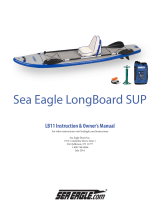Page is loading ...

by
SLSUPB105 - SLSUPB125 - SLSUPB135 - SLSUPB145
Thunder Wave SUP
Stand Up Water Paddle-Board
SLSUPB125
SLSUPB135
SLSUPB145
SLSUPB105

www.PyleUSA.com
INTRODUCTION
IMPORTANT! PLEASE READ THIS MANUAL CAREFULLY, AND IN ITS ENTIRETY, BEFORE INFLATING, ASSEMBLING OR
USING YOUR THUNDER WAVE SUP.
Please read this manual carefully before using this product. Familiarize yourself with the features of the SUP and ask for
professional training if you are inexperienced in handling this type of board. For your full enjoyment it is important to follow
proper safety procedures and rules of the waterway that apply to all SUPs. Always check the local weather conditions before
taking the SUP out. Do not let yourself get caught out by currents in tidal inlets, open seas, small channels or shallow water
regions.
2

www.PyleUSA.com
WHAT’S WHAT?
Leash Plug
Air Valve
Tie down Bungee Cords
Carrying Handle
SLSUPST15
Sup Seat
*sold separately
Fins
3

www.PyleUSA.com
GETTING STARTED
CONTENTS
• Board x 1
• Bag x 1
• Repair kit x 1
• Hand pump x 1
• Leash x 1
• 3 piece SUP paddle x 1
INFLATING THE SUP BOARD
1. Roll out the SUP board until it is laying at with top side facing up.
2. Push the air valve down while at the same time twisting slightly. This will put the air valve in the up position
(Note: when the air valve is UP, air can only ow into the SUP board. When it is in the DOWN position, air can ow
in and out of the SUP board).
3. Attach the pump to the air valve with a half twist motion (clockwise).
4. Begin pumping air into the SUP board. Try to maintain proper posture and leverage while you pump
(Note: You can split the pump into parts--the pump, hose and valve--by screwing the ends together).
5. Remove the pump with a half twist motion (counter-clockwise).
6. Screw on the air valve cap.
4

www.PyleUSA.com
GETTING STARTED
SUP BOARD MR PUMP
Your SUP Board comes with a high pressure pump. This pressure pump, pumps low volume of air with each pump-
ing motion. It takes longer to ll the board with air, but allows the board to reach a higher air pressure. This is good
for achieving maximum performance from the board.
The SUP board air pump is also lubricated with oil. To ensure the life of the air pump, make sure the pump is fully
lubri-cated before and during each use. To lubricate the pump, simply open the top and place a few drops of
oil/grease on the gasket and tube. Take a second to clean the air lter, also located inside the top of the pump.
THE PADDLE
Your board paddle comes in three pieces. To build the paddle, hold the button in while sliding the pieces together
until they click into place. The last section (top) of the paddle is adjustable.
To nd the ideal height for your paddle, start by building the paddle so it is 6 inches taller than your own height.
From this point, adjust the top section up or down until the length is comfortable for you. A longer paddle is better
suited for a smooth, easier paddling motion. A shorter paddle is good for performance or competition riding.
5

www.PyleUSA.com
GETTING STARTED
REPAIR KIT
If your board needs repair, use the patches in the repair kit and follow these steps:
1. Deate the board completely, lay it at and wait for it to dry.
2. Cut a patch that is 2 inches larger than the tear/rip all the way around.
3. Use alcohol to clean the repair area.
4. Apply three coats of adhesive to the patch and the board. Wait 5 minutes in between each coat.
5. Place the patch over the tear/rip. The adhesive will react quickly, so make sure the positioning is precise/accurate.
Use the roller to ensure the patch lies at and even.
6. Wait 24 hours before re-inating the board.
STORAGE
Having an inatable SUP board makes portability and storage very easy. Here are some simple suggestions if
you plan on traveling with your SUP board.
• Avoid storing your SUP board in direct sunlight.
• If you have to store your board inated between uses, attach your pump to make sure the board is carrying the
correct air pressure.
• Do not roll up the board too tight when storing it while deated.
• If ns become bent, place them in boiling water and use heat (e.g. hairdryer) to bend them back into
position.
6

www.PyleUSA.com
APPENDIX
FOR YOUR SAFETY
• Check your board and equipment before going in the water.
• Try to avoid going on the water alone.
• Always have a mode of communicating while on the water.
• Check weather conditions and tide before going out to ride.
• Avoid paddling when winds are blowing away from shore.
• Be aware of tide and water ow and how it will affect your traveling time.
• Wear wetsuits or drysuits.
• Always wear a life jacket or some sort of oatation device.
• Always wear your board leash.
• Take a rst aid course and always travel with rst aid equipment.
• Avoid traveling with the board if you cannot swim.
• Do not go out on the water if you have been drinking or are under the inuence of drugs.
7

by
/

